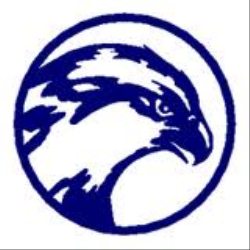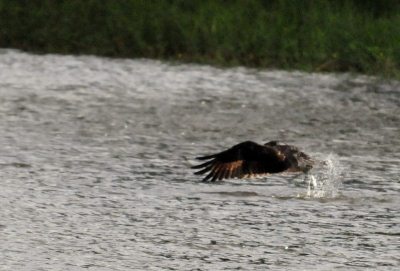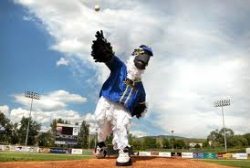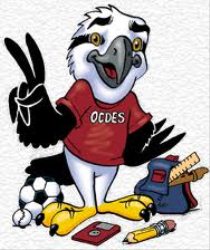|
The
Osprey
Stopping for a few minutes at the plantation to show the Moths
(Mistress and Master of the House a.k.a the Walkers) what an Anhinga looked
like, our assistants spotted this chap flying toward us. We were impressed
as during the week their spotting skills have improved from seeing a tree to
seeing a bird in a tree. This chap was indeed correctly identified as an
Osprey.
The Osprey (Pandion
haliaetus), sometimes known as the sea hawk or fish eagle, is a diurnal,
fish-eating
bird
of prey. It is a large raptor,
reaching twenty four inches in length with a six foot wingspan. It is brown on
the upperparts and predominantly greyish on the head and underparts, with a
black eye patch and wings. The Osprey tolerates
a wide variety of habitats,
nesting in any location near a body of water providing an adequate food supply.
It is found on all continents except Antarctica although in South America it
occurs only as a non-breeding migrant.
As its other common name suggests, the Osprey's diet consists almost exclusively
of fish. It has evolved specialised physical characteristics and exhibits unique
behaviour to assist in hunting and catching prey.
As a result of these unique characteristics, it has been given its own taxonomic
genus,
Pandion and family,
Pandionidae. Four subspecies
are usually recognised. Despite its propensity to nest near water, the Osprey is
not a sea-eagle.
Taxonomy: The Osprey was one of the many species described by Carolus
Linnaeus in his 18th century work, Systema
Naturae, and named as Falco
haliaeetus. The genus Pandion was described by the French
zoologist
Marie
Jules César Savigny in 1809. The Osprey differs in several respects
from other diurnal
birds of prey. Its toes are of equal length, its tarsi
are reticulate,
and its talons are rounded, rather than grooved. The Osprey and Owls are the
only raptors whose outer toe is reversible, allowing them to grasp their prey
with two toes in front and two behind. This is particularly helpful when they
grab slippery fish. It has always presented something of a riddle to
taxonomists, but here it is treated as the sole member of the family
Pandionidae, and the family listed in its traditional place as part of the order
Falconiformes.

A good left footed strike
Then speed made him crash and burn, but
well recovered - proving him to be a
youngster.
Etymology:
The
genus name Pandion is after the
mythical Greek king Pandion
of Athens
and grandfather of Theseus,
who was transformed into an eagle. The specific epithet haliaetus is derived from the Greek
ἁλιάετος "sea
eagle/Osprey". The origins of Osprey are obscure; the word itself
was first recorded around 1460, derived via the Anglo-French
ospriet and the Medieval
Latin avis prede
"bird of prey," from the Latin
avis praedæ though the Oxford
English Dictionary notes a connection with the Latin
ossifraga or "bone breaker" of
Pliny
the Elder. However, this term referred to the Lammergeier.
Description: The upperparts are a
deep, glossy brown, while the breast is white and sometimes streaked with brown,
and the underparts are pure white. The head is white with a dark mask across the
eyes, reaching to the sides of the neck. The irises of the eyes are golden to
brown, and the transparent nictitating membrane is pale blue. The bill is black,
with a blue cere,
and the feet are white with black talons. A short tail and long, narrow wings
with four long, finger-like feathers, and a shorter fifth, give it a very
distinctive appearance. The sexes appear
fairly similar, but the adult male can be distinguished from the female by its
slimmer body and narrower wings. The breast band of the male is also weaker than
that of the female, or is non-existent, and the underwing coverts of the male
are more uniformly pale. It is straightforward to determine the sex in a
breeding pair, but harder with individual birds. The juvenile Osprey
may be identified by buff fringes to the plumage of the upperparts, a buff tone
to the underparts, and streaked feathers on the head. During spring, barring on
the underwings and flight feathers is a better indicator of a young bird, due to
wear on the upperparts. In flight, the Osprey
has arched wings and drooping "hands", giving it a gull-like
appearance. The call is a series of sharp whistles, described as cheep, cheep or yewk, yewk. If disturbed by activity
near the nest, the call is a frenzied cheereek!
Diet: Fish make up 99% of the Osprey's diet. It typically takes fish
weighing between five and ten ounces and about ten to fourteen inches in length,
but the weight can range from two to sixty eight ounces. Ospreys have vision that is well adapted to detecting underwater
objects from the air. Prey is first sighted when the Osprey is thirty to a
hundred and thirty feet above the water, after which the bird hovers momentarily
then plunges feet first into the water. The Osprey is particularly well adapted
to this diet, with reversible outer toes, sharp spicules on the underside of the
toes, closable nostrils to keep out water during dives, and backwards-facing
scales on the talons which act as barbs to help hold its catch. Occasionally,
the Osprey may prey on rodents, rabbits, hares, amphibians, other birds, and small reptiles.

Reproduction: The Osprey breeds by freshwater lakes, and sometimes on coastal
brackish waters. The nest is a large heap of sticks, driftwood and seaweed built
in forks of trees, rocky outcrops, utility poles, artificial platforms or
offshore islets. Generally, Ospreys reach sexual maturity and begin breeding
around the age of three to four years, though in some regions with high Osprey
densities, such as Chesapeake
Bay in the U.S., they may not start breeding until five to seven years old, and
there may be a shortage of suitable tall structures. If there are no nesting
sites available, young Ospreys may be forced to delay breeding. To ease this
problem, posts are sometimes erected to provide more sites suitable for nest
building. The platform design developed by one organization, Citizens
United to Protect the Maurice River and Its Tributaries,
Inc. has become the official design of the State
of New Jersey, U.S.A. The platform plans and materials list, available online,
have been utilized by people from a number of different geographical regions.
Ospreys usually mate for life. Rarely, polyandry has been recorded. The breeding season varies according to latitude;
spring (September-October) in southern Australia, April to July in northern
Australia and winter (June-August) in southern Queensland. In spring the pair
begins a five-month period of partnership to raise their young. The female lays
two to four eggs within a month, and relies on the size of the nest to conserve heat.
The eggs are whitish with bold splotches of reddish-brown and are about
2.4 x 1.8 inches and weigh about 2.4 ounces. The eggs are
incubated for about 5 weeks to hatching. The newly hatched chicks weigh only two ounces and fledge in eight to
ten weeks. When food is scarce, the first chicks to hatch are most likely to
survive. The typical lifespan is seven to ten years, though rarely individuals
can grow to as old as twenty five years. The oldest European wild osprey on
record lived to be over thirty years of age.
The vessel - Osprey
Legends and Odds: Nisos,
a king of Megara
in Greek
mythology, became a sea
eagle or Osprey, to attack his daughter after she fell in love with
Minos,
king of Crete.
The Roman writer Pliny the
Elder reported that parent Ospreys made their young fly up to the sun
as a test, and dispatch any that failed.
Another odd legend
regarding this fish-eating bird of prey, derived from the writings of Albertus
Magnus and recorded in Holinshed's
Chronicles, was that it had one
webbed foot and one taloned foot.
There was a medieval
belief that fish were so mesmerised by the Osprey that they turned belly-up in
surrender, and this is referenced by Shakespeare
in Act 4 Scene 5 of Coriolanus:
I think
he'll be to Rome, As is the osprey to the fish, who takes it, By sovereignty of
nature.
The Irish poet William
Butler Yeats used a grey wandering Osprey as a representation of
sorrow in The Wanderings of Oisin and
Other Poems (1889).
  
The Osprey is
depicted as a white eagle in heraldry,
and more recently has become a symbol of positive
responses to nature, and has been featured on more than fifty postage
stamps used as a brand name for various product, sports teams
(examples include the Ospreys, a Rugby Union team; the
Seattle
Seahawks, an American
football team and the North
Florida Ospreys) or as a mascot (examples
include the Geraldton
skiing team in Australia;
the University
of North Florida; Salve
Regina University; Wagner
College; the University
of North Carolina at Wilmington and the Richard
Stockton College).
ALL IN ALL A GOOD LOOKING
LAD
|















